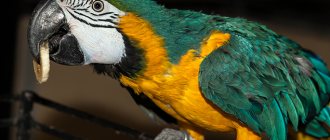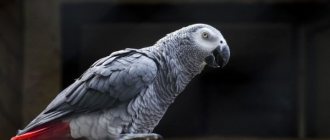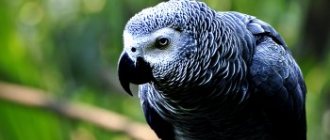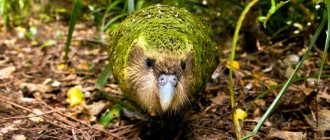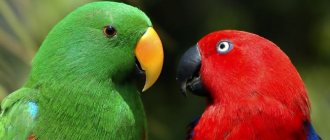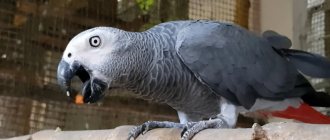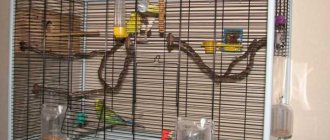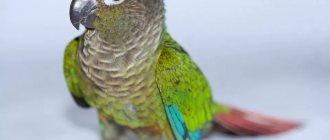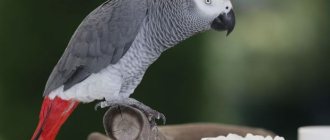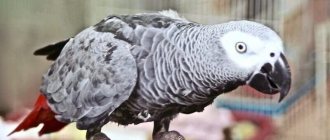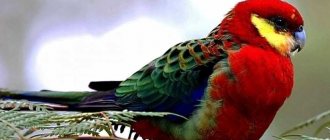The Jaco parrot is usually called the gray parrot (translated into Latin as psittacus erithacus). African gray parrots are quite talented, they are talkative, they can repeat any sound effect, which makes them excellent human companions.
Owners of African gray parrots report that their birds constantly chatter and sense the emotional state of their owners. This breed (African Gray Parrot) is not only a great companion to chat with, but also has excellent mental abilities, which gives them the interesting nickname "Einsteins of the bird world."
Appearance
What is Jaco's appearance like? The individual has a rather short tail, which can be ten centimeters. The main color of the feathers is gray, but white can be seen in some areas. There is also a green appearance, like macaws. The body plumage has a bright end because this color shimmers smoothly. The feathers around the eyes and lower belly are usually light grayish, actually white. Paws are blackish in color. Sexual avian dimorphism is not very pronounced.
It is not always possible to determine the gender: a boy or a girl. Only sometimes can a male differ from a female in having a larger head, although the exact sex is determined in laboratories. The tail may be red or brown. In addition to the brown-tailed one, there is also a royal one, which has a reddish tint to the tail and entire body. It is commonly called the brown-tailed gray. This species has red feathers over the entire body area. In appearance, it is a rather inconspicuous gray bird, but until you see it closer and examine the details. There is a crested relative of the macaw and the gray corella.
general information
According to the international classification of biological species, Jaco belongs to the genus of blunt-tailed parrots of the parrot family. A curious fact is that this species is the only one of its kind.
These are quite large birds, the size of which reaches about 35 centimeters, it should be noted that usually females are somewhat smaller than males. In this case, the wingspan can be about 60-65 centimeters. The tail of an adult parrot is approximately 8 centimeters in length.
The plumage of the Jaco parrot is characteristic of its species. Thus, most of the feathers have a silvery-ashy tint. At the same time, they have a slightly lighter edging around the edges. Thanks to this feature, from afar the plumage of a parrot can be mistaken for scales. The tail stands out clearly against the background of the rest of the body. The plumage on it has red or brown shades.
The bird's beak is black. With the help of its beak, the bird obtains food and builds nests, so it is quite massive.
Jaco's eyes are round and have yellow irises. However, this only applies to adults. Young birds and chicks have black eyes.
In general, Jaco has a rather characteristic appearance, so it is almost impossible to confuse him with other types of parrots.
In the photo there is a Jaco parrot:
Parrot size and weight
Jaco is a medium-sized feathered bird. The length of its body can reach forty centimeters, the length of the wing is twenty to twenty-five centimeters. They weigh on average 410 grams. Weight depends on the size of the bird, its age and the conditions in which it lives, and the quality of care.
Usually, domestic ones weigh a little more than wild ones, due to constant feeding. The cage also affects weight. In a small cage, the animal will move and fly less and, accordingly, gain weight.
Spreading
In general, there are more than three hundred and at least a dozen that are known to us and are kept as pets. Jaco is rare in our country; its people could not even see it live before, although they had heard a lot about this species.
For some reason, this particular species was prohibited from being imported into the Union of Soviet Socialist Republics; even now you rarely see them on the territory of our countries. Representatives of the species live in Africa and are able to quickly get used to people.
Range, habitats in the wild
They come from the African continent. In the wild, their habitat varies depending on the breed of bird.
Habitat of Grays in the wild
The brown-tailed gray parrot inhabits the coasts of Guinea, Liberia, and Sierra Leone. The Red-tailed Jaco lives in the tropical forests of Tanzania and Angola. The small brown-tailed parakeet lives in the Gulf of Guinea, as well as on the islands of Bioko and Principe.
Lifestyle
Feathered Jaco breeds spend a significant part of their lives in trees. They usually fly away at an early age to search for food. They eat berries, nuts and greens. Often flocks fly across grass fields. Previously, there were so many of them that they often ate up all the crops. Nests are formed in tree hollows.
During the mating season, males dance to females. If she likes it and joins in, this behavior is repeated several times a day. Females are able to lay three to four eggs and after thirty days the chicks begin to hatch. After two months they fly away, but still need parental care. The fosterling quickly gets used to people.
Character and behavior
The characteristics of the bird are quite simple. Jaco is the most talkative of all known breeds in our time. The speaker, like a human prodigy, will be able to learn words with amazing speed and reproduce them very clearly, while respecting the intonation heard. They are usually quite active and get along well with children if they get used to them.
We can say that they can cheer you up on the most dull day, when you start talking for hours on end. There are known cases when they blew up the Internet. The most famous grays were Alex, Prokhor, Grigory and Zhorik. You can see each of them singing online using human words. There are also cases of aggression in parrots. It also happened that the Jaco parrot bit its owner. But usually there are certain reasons for aggression.
Intelligence
The intelligence of this bird is such that they are simply stunning with their abilities. They learn human speech at an incredibly fast speed; moreover, they use other knowledge that they have acquired from humans. Teaching a bird to speak is not difficult.
Jaco is perhaps the smartest and most talented parrot. Representatives not only speak phrases, but know their meaning. The bird speaks different languages. Many parrots are able to count, identify colors, and carry out simple tasks.
There are cases when a parrot is a talker, saying in words that he wants to eat. Jaco's intelligence allows him to communicate his desire to eat or sleep. With birds there is an opportunity not only to chat when it gets boring, but also to become a true friend for him. Talking parrots feel like they are people's friends, but if the parrot's owner does not have sincere intentions, then he will never become their friend. They love to communicate with people.
How to care for a Jaco parrot at home
The Parakeet is a social bird that requires both proper care and lots of companionship. In addition to a spacious cage and a balanced diet, the parrot needs constant attention - playing with it, communicating, pampering it with a variety of toys.
Arranging a cage for a Jaco parrot
Grays have a peculiar disposition, so it is not so easy to please them with housing. The gray parrot does not like any restrictions, especially space restrictions. This should be remembered when selecting a cage. Its minimum size should be 0.65*0.45*0.80 m.
Moreover, its height should be no less than 1.5–2 times the width. To prevent the bird from breaking the cage, it is necessary to choose a metal structure with rods at least 0.3–0.5 cm thick with a distance of 3–4 cm between them. It is necessary to attach a feeder, a drinker, perches, a piece of chalk, and a mineral stone to the cage.
The shape of the bird's house does not matter for the parrot, so it can be selected depending on your own interests or the interior of the apartment.
Special attention is paid to the cage lock. Jaco is a smart bird, and it will not be difficult for her to open a regular bolt or unhook the lock. To prevent escape, it is better to install a small carabiner with a locking system or a furniture latch.
It is better to place the cage on a hill (a table or a special support), in a secluded, remote place.
In order for a bird to accept its new home, it must be accustomed to it:
- carry the parrot on your hand into the cage, but do not close it;
- repeat a certain command (for example, “house”) when bringing the bird into the cage, and be sure to reward with treats when the command is successfully executed;
- In the first days, stay with the parrot longer, and leave him alone indoors less.
Forbidden:
- forcing the parrot into the cage by force;
- lure inside by placing treats there.
To prevent the bird from getting bored in the absence of its owner, it will need toys for entertainment.
When choosing accessories for fun, preference should be given to forage toys. Their work is based on the interaction of the chick with the fun, inside of which a treat is hidden, which stimulates the bird's natural ability to obtain food. To get food, you need to press, pull, yank, twist.
The following are also suitable:
- bath;
- mirror;
- ladder;
- hanging swing;
- bell;
- tunnel house;
- parrot toy;
- ball;
- carousel.
Video He is smarter than. Talking Jaco, African gray parrot
What to call Jaco
The gray parrot is named so that the chick likes the name. When choosing a name, follow these rules:
- The name should be short (maximum three syllables) so that the parrot can learn it;
- Choose a name that contains hissing and voiceless consonants (k, e, sh, a, sch, zh, h, t, g, d, p, p, a, e, i, y) - those letters that a bird can pronounce ;
- Avoid complex or two-syllable names, such as Robin Hood or Bonifacio.
In order for a parrot to remember its name, it needs to repeat the name every day for 10-15 minutes in a gentle, kind voice. Over time, the pet will understand that there is no danger in repeating its name, and will begin to respond to it.
| Example names for Jaco | ||
| Men's | Women's | Universal |
| Kesha, Gosha, Zhora, Kir, Jacques, Joe, Georges, Kai, Tristan, Chuk, Huck, Agar, Rurik, Argus, Freddie, Chester, Peter, Yolk, Chuck, Carlos, Diego, Juan, Horn, Donut, Darius. | Audrey, Diva, Rose, Gerda, Wendy, Isolde, Erica, Desiree, Cassie, Peppa, Betty, Kitty, Peggy, Bijou, Greta, Berta, Augusta, Kerry, Jessie, Chiara, Tiara, Aria. | Chris, Gary, Ricky, Toby, Tahiti, Fiji, Bioko, Robbie, Archie, Chicky, Jerry, Nikki, Cookie, Toto, Coco, Chichi, Rocky, Arnie, Josie, Cherry, Ciro, Tutu, Pepo, Toto. |
Jaco has difficulty with the letters “c, z, s,” and he cannot pronounce the sounds “l, m, n” at all. Therefore, if we teach a bird to say a name with such letters, we will hear the parrot stutter or burr.
What to feed your Jaco parrot
| Diet of the domestic parrot Jaco | |
| Authorized products | Prohibited Products |
| all types of grains; legumes; sprouted grain; porridge (buckwheat, millet, rice); nuts in small quantities so as not to cause obesity; vegetables (carrots, cabbage, cucumbers); seedless fruits (bananas, apples, pears, plums, apricots); berries (currants, strawberries, grapes, blueberries and pomegranate seeds); greens (dandelion leaves, lettuce, clover, radish tops, spinach); mineral stone and tree branches; vitamin and mineral supplements; special store-bought food for parrots; Animal feed (meat, eggs, fermented milk products) is given no more than once a month. | juices; fresh bread; avocado; persimmon; mango; potato; seasonings; carbonated drinks. |
| The sippy cup should always contain clean drinking water, which is changed daily. | |
The diet of wild birds varies depending on the time of year. Therefore, including different seasonal foods for domestic gray parrots is normal, and sometimes even beneficial. Instead of treats, you can offer your parrot fried sunflower seeds or candied fruits from permitted fruits.
Care and hygiene
With rational care, a gray parrot will become a true friend for the whole family. But you will have to take care of your pet every day.
Key aspects of proper care:
- Daily wet cleaning in and around the cage (birds are sloppy and scatter food), every week - general cleaning.
- Clean the feeder and drinker every day.
- Periodically bathe your pet in the shower.
Under no circumstances should Jaco's wings be clipped. Trimming feathers can cause behavioral problems and will also remove the ability to fly. And as you know, flying provides the necessary physical activity and helps control and coordinate the movements of your feathered friend.
An important point that can often be encountered in everyday life is the movement of a bird. The Gray is a rather large bird, and transporting it, for example, to a dacha for the summer or taking it for a preventive examination to a doctor is not entirely easy. For this it is better to use special carriers.
An excellent carrying option for both the owner and the Jaco parrot is a backpack carrier. This is a convenient backpack box in which a bird can be transported over long distances. In such a backpack it is allowed to carry a feathered animal on an airplane, and it is also convenient to travel by car, simply by attaching it to the seat with seat belts.
Diseases prevention, vaccination
| Non-communicable pathologies | Infectious diseases | Parasitic diseases |
| 1. Self-plucking is most often found in representatives of large species living in cages. The pathology is caused by unfavorable living or nutritional conditions, psychological trauma, stress, draft, fear, dry air, and parasite infestation. In advanced cases, the bird becomes completely naked, and it is no longer possible to cure this. 2. Obesity in parrots is a disease that is caused by an unbalanced diet and lack of physical activity. If left untreated, reproductive function disappears and liver cirrhosis develops. | The disease is caused by infectious pathogens that enter the parrot's body through contaminated water or food, droppings, insect bites, or contact with an infected pet. 1. Salmonellosis; 2. Paratyphoid; 3. Aspergillosis; 4. Smallpox; 5. Candidiasis; 6. Staphylococcosis; 7. Spondylitis; 8. Spondylolisthesis. | The main reason parrots become infected with helminths is unsanitary living conditions. Among the most unpleasant parasites are down feather eaters, which feed on the barbs of feathers, down, blood and skin of the parrot. |
It is worth remembering that at the slightest suspicion of a disease, the parrot must be taken to a veterinarian to make a final diagnosis. Only a specialist can correctly diagnose the pathology and select rational treatment.
To prevent the development of pathological changes in the body, you must adhere to the following recommendations:
- Take your pet to the veterinarian for a preventive examination every year.
- Keep the cage clean.
- Every three months, disinfect the bird's home and equipment.
- Protect the bird from possible causes of injury.
- Vaccinate birds against staphylococcosis and bird flu.
Breeding Jaco parrots
It is possible to breed Gray Jacos in captivity, but for this the birds must be kept in large enclosures and they must be provided with special care. Reproduction begins in May. A couple of parrots are placed in an isolated enclosure and they try not to disturb them. A nest is placed in the aviary - a box measuring 0.28 x 0.28 x 0.6 m, which the birds arrange independently when laying.
During the mating season, the male performs a wedding dance lasting 5-10 minutes. He ruffles his plumage and begins to dance around his beloved, making specific sounds similar to grunting. The female repeats the male's melody, and then assumes the pose of a chick asking for food. The male imitates feeding. There may be several such wedding steps per day. During the mating season, which lasts from 1 to 2 weeks, the female lays 3-4 eggs and then incubates them for 26 days. The chicks are fed for 2.5 months. Then the chicks fly out of the nest, but for some time they still need the help of their parents.
The smartest parrot Alex
Alex was an African parrot born in 1976. He became famous for being the subject of a psychological experiment at three universities - the University of Arizona, Harvard and Brandeis University.
His uniqueness lay not only in his ability to learn the names of individual objects, but also in his ability to identify objects and their colors regardless of their shape.
In 1977, Irene Pepperberg, a scientist, psychologist and professor at Brandeis University and Harvard University, bought one-year-old Alex from a pet store. At the time, she wanted to test whether these birds could cope with complex language-related problems. He demonstrated the intelligence of a five-year-old and the emotional level of a two-year-old, and he had not developed to his full potential by the time of his death, Pepperberg said.
In her study, Pepperberg argued that if the intelligence of one bird could be compared to that of dolphins and primates. Or maybe he was an unusual one who learned a large number of words in a short time. Perhaps he did not study them mechanically, but rather creatively with the ability to understand what he said.
When asked about the shape, color or material of a certain object, Alex could give an accurate description. For example, when he was shown keys of different sizes, shapes and colors, there was no problem identifying the object. When he was put in front of a mirror and asked, “What color are you?” he said he was grey, looking at himself. He learned that his color was gray after being told six times. To this day, Alex is the only animal that answers the question about itself.
Alex died suddenly in two thousand and seven, at the age of thirty-one. Although they live on average sixty years, his death came as a surprise to everyone who was interested in this study, especially considering that he was in good health.
Pepperberg said it's a huge loss, but it won't stop her bird research. After all, she has two more birds in her laboratory, but they are not as capable as their predecessor.
Nutrition
The African gray parrot eats only plant foods. From a young age, he learns not only to look for food, but also to distinguish edible plants from poisonous ones. Basically, the Gray eats various fruits. The diet of the African gray parrot includes the following components:
- flowers;
- bark;
- grains;
- seeds;
- succulent shoots;
- green leaves;
- fruits;
- nuts.
Although the African parrot flies heavily and reluctantly, it travels considerable distances in search of food. To select ripe fruits and nuts, the Gray Gray flies from one tree to another and even climbs branches with the help of a powerful beak and tenacious fingers. The African gray parrot often raids plantations with unripe corn, causing discontent among farmers.
Price
Many people wonder: how to choose a Gray and how much does it cost? Pets live on average from fifty to sixty years, so when you buy a pet, you are buying a friend for life.
Thanks to their talents, birds are very popular. There is a brown-tailed species and a red-tailed one, their cost differs significantly, due to what the species looks like. So, untrained speech in the market or on the Internet through various advertisements can be purchased for 15 - 35 thousand rubles.
It all also depends on where you purchase the animal. The cost is higher in a pet store, where their price is approximately seventy to one hundred and fifty thousand rubles. They usually have their own catalog, which can be viewed online.
Breeders have fosterlings in the price range from sixty to one hundred and twenty thousand rubles. Even those who can speak and are quite old cost from three hundred thousand rubles and even more. Don’t forget to include in the price what you will feed your pet.
Next
Gray Red-tailed Gray and all information and breed
How many years does a Gray live?
The lifespan of grays in nature is difficult to track, since observations of flocking birds that roam over large territories are difficult. Naturalists only guess how long a gray parrot lives in its natural environment - this period does not exceed one and a half decades. Individuals, under favorable conditions, can live much longer. But domestic parrots are able to live to a ripe old age, which occurs at about 40-50 years of age. The scientific journal International Zoo Yearbook reports reliable data on Gray Coat, who died at the age of 49.7 years.
